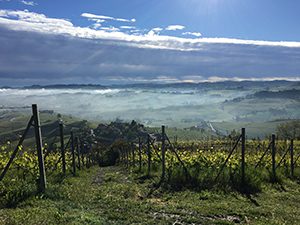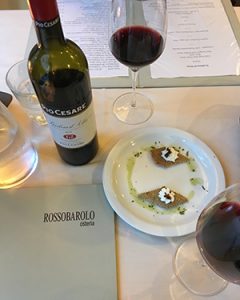By Sarah Cribari

The towering snow-capped Alps jutted into the sky behind us, shrinking as we drove southward through the gently rolling green hills. Dark church steeples and shadowy medieval towers dotted the distant landscape, barely visible through the receding fog. As we wound our way through the twisting side roads, neat rows of vineyards zipped past the window, punctuated by an occasional field of grazing cattle. If we hadn’t detrained in Turin an hour ago, I’d have thought I dozed off and woke up in a Hans Christian Andersen story. But this wasn’t a fairy tale – it was the Piedmont region of Northwestern Italy. We were headed to the town of Barolo to escape the tourists, soak in the scenery, and enjoy the region’s world-class wine.
The wine region is outshined by its more popular cousin, Tuscany. Barolo seems to be undiscovered or perhaps forgotten by American tourists. But here you’ll find fewer visitors and, you can argue, better wines. Getting to Piedmont is no more difficult than Tuscany. You can take the train from Milan to Turin or several smaller towns such as Alba or Asti. From there you can rent a car to explore the nearby vineyards – just as you would rent a car in Florence and drive to the small towns of Siena or Montepulciano. There are also tour buses available to drive you to the villages and wineries of your choice. We decided to go for the self-guided option and rented a car in Turin. We drove into the heart of Northwestern Italy’s wine country.
As we maneuvered our car down the final steep bend in the road, we saw the tiny town of Barolo tucked between vineyards with its castle casting shadows over the town. Even though it’s a village of fewer than 1,000 residents, there are plenty of options for lodging, including rooms at local farms or wineries in the surrounding countryside, or several B&Bs in town. We wanted to experience as much as possible over the weekend, so we chose to stay in a B&B that was centrally located among the shops and restaurants.

As with many medieval cities, the most iconic building in town is the castle. In Barolo, Castle Falletti, houses the Wine Museum of Barolo and the Enoteca Regionale where you can try some of the region’s top wines. While we were certainly entertained by the various dioramas and interactive installations in the museum, we felt our time was better spent talking to the locals, eating our weight in pasta, and wandering the little alleyways that curved through the village.
The entire area is a UNESCO World Heritage site so you can expect wonderfully preserved buildings and plenty of history of the winemaking industry. Having spent the previous week in Tuscany, we should have remembered that most wineries in Italy are smaller, family-run establishments, that require reservations for tastings and tours. But unfortunately, we completely forgot to book an appointment at any winery in Barolo, including the regal Marchesi di Barolo. The yellow building looks lovingly down upon the town from its high perch among the vineyards. Without an appointment, we were resigned to trying the wines at the various enotecas in town.
It wasn’t too much of a disappointment, the local enotecas have wonderful selections from the area’s DOCGs (Denominazione di Origine Controllata e Garantita – controlled and guaranteed designation of origin). It’s the highest guarantee of quality from specific regions – basically, it’s the good stuff. We learned our lesson – absolutely make reservations for wineries in Italy. Its easy to do with information from the winery’s website.
English is much less prevalent in this part of the country than in Rome or Tuscany, but the locals who did speak English were enthusiastic to practice and chat with us about where we were from and how we liked their town.
Our B&B hosts invited us to share some wine and antipasti with them and learn a bit about each other. It wasn’t easy with their limited English and our nonexistent Italian, but we all managed to convey our thoughts with charades and lots of Google Translate. We ended up laughing more than talking, but the act of sharing a meal and glass of wine with people who live across the globe suddenly changed us all from strangers to friends.
If you would like to purchase this article for your publication, please click here to contact the author directly.
Most important information about generics
